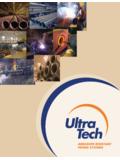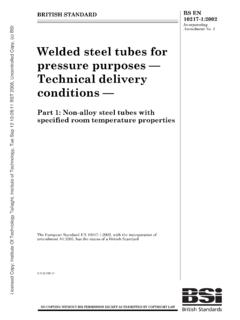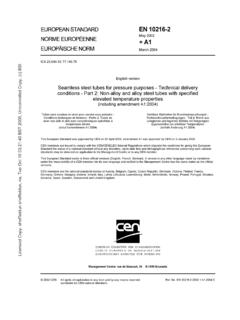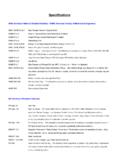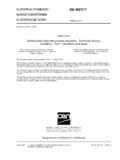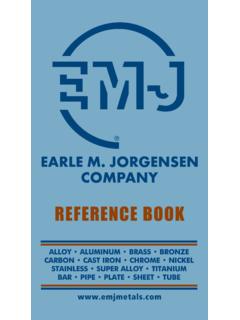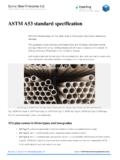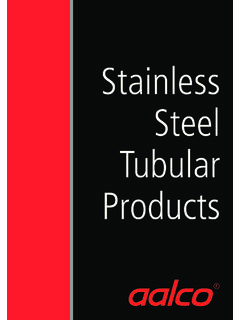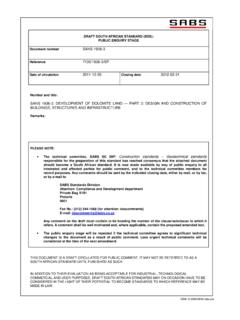Transcription of Sandvik254 SMO - Applied Alloys Australia
1 A)According to EN 10088, valid for sheet/plate, strip, semifinishedproducts, bars, rods and sections for general purposes (not forpressure purposes).b)Nearest equivalent gradec) correspond to and offset yield )Based on L0= S0, where L0is the original gauge length and S0the original cross-section tubeSandvik254 SMOS-1884-ENG April 1999 Cancels all previous editionsSandvik 254 SMO is an austenitic stainless steel of the ELC type developed for use inseawater and other aggressive chloride-bearing media. The steel is characterised by thefollowing properties: excellent resistance to pitting and crevice corrosion high resistance to general corrosion high resistance to stress corrosion cracking higher strength than conventional austenitic stainless steels good weldabilityCHEMICAL COMPOSITION (NOMINAL), %CSiMnPSCrNiMoN of steel UNS S31254 EN ) ) DIN X 2 CrNiMoCuN 20 18 6 AFNOR Z1 CNDU SS 2378 Product standardsSeamless tube and pipe: ASTM A269, A312, NFA 49-217 Welded tube and pipe: ASTM A249, A269 , A312, A358.
2 A409 Fittings:ASTM A182 Bars:ASTM A276, A479, EN 10088-3a)Forged products:ASTM A473 ApprovalsTube and pipe, fittings and flangesUNS S31254 (254 SMO) has been approved by the AmericanSociety of Mechanical Engineers (ASME) for use according toASME Boiler and pressure Vessel Code section VIII, div. SMO is a trademark owned by Avesta Sheffield ABFORMS OF SUPPLY Seamless tube and pipe Finishes and dimensionsSeamless tube and pipe are supplied in dimensions up to 230mm outside diameter in the solution annealed and white-pickled condition or in the bright-annealed forms of supply Welded tube and pipe Fittings and flanges Bar steel Forged products Cast productsMECHANICAL PROPERTIESThe following values apply for material in the solution 20 C (68 F)Metric unitsProof strengthTensile strength ) )RmAd)A2"VickersMPaMPaMPa%% unitsProof strengthTensile strength ) )RmAd)
3 A2"Vickersksiksiksi%% MPa = 1 N/mm22 CORROSION RESISTANCEI ntroductionIn solutions containing halides such as chloride and bromideions, conventional stainless steels can be readily attacked bylocal corrosion in the form of pitting corrosion, crevice corrosionor stress corrosion cracking. In acid environments, the presenceof halides also accelerates general pure sulphuric acid, 254 SMO is much more resistant thanAISI 316, and in naturally aerated sulphuric acid containingchloride ions 254 SMO exhibits higher resistance than 904L,see figure corrosion crackingOrdinary austenitic steels of the AISI 304 and 316 type areprone to stress corrosion cracking in chloride-containing solu-tions at temperatures exceeding about 60 C (140 F). For theaustenitic steels, resistance to SCC increases with increasingnickel and molybdenum contents.
4 The tables below give theresults of two accelerated tests, showing that 254 SMO has avery good resistance to 1. Strength values (min. values) for 254 SMO and allowable stressaccording to ASME Boiler and pressure Vessel Code section VIII, div. heat capacityTemperatureJ/(kg C)TemperatureBtu/(lb F) C expansion,mean values in temperature ranges (x10-6)TemperaturePer CTemperature, FPer F C of elasticity,(x103)TemperatureMPaTemperatu reksi C , C ( F)6013bStrength, MPa600400200700500300100020(68)100(210)2 00(390)300(570)400(750) stress acc. toASME section VII, div. 10255075100ksiImpact strengthIts austenitic structure gives 254 SMO very good impactstrength, both at room temperature and at low high temperaturesIntermetallic phases are precipitated within the temperaturerange of 600-1000 C (1110-1830 F). The steel should therefo-re not be exposed to these temperatures for prolonged Tem-Proof CMPaMPa PROPERTIESD ensity, g/cm3, lb/in3 Thermal conductivityTemperatureW/m CTemperatureBtu/ft h F C corrosion cracking tests in boiling 25% NaCl solution, pH = to failureRemarkAISI 316<150 hPitting904 LNo failure (1000 h)Crevice corrosion254 SMONo failure (1000 h)No attack340 (105)60 (140)80 (175)100 (210)120 (250)H2SO4, weight-%20 (68)Temperature, C ( F)Boiling point curve010203040254 SMO904L6014bFigure 2.
5 Isocorrosion diagram, mm/year (4 mpy) in naturallyaerated sulphuric acid containing 2000 ppm chloride (120)40(105)30(85)20(68)10(50)0 AISI 316L904L254 SMOT emperature, C ( F)6016bFigure 3. Critical pitting temperature (CPT) in 3 % NaCl, 600 corrosionIts high chromium content and particularly the molybdenumcontent give 254 SMO excellent resistance to pitting and crevi-ce corrosion. The high nitrogen content also improves results of laboratory determination of the critical pittingtemperature (CPT) in 3 % NaCl are shown in figure 3, where itcan be seen that 254 SMO possesses very good resistance inwater containing chlorides. 254 SMO is therefore a suitablematerial for use in for example , C ( F), 600 mV/SCE100(210)75(165)50(120)25(75)0 AISI 316L904L254 SMO6015bFigure 4. Critical crevice corrosion temperature in FeCl3for 254 SMO,AISI 316L and 904L.
6 According to ASTM corrosionThe weak point of conventional stainless steels is their limitedresistance to crevice corrosion. In seawater, for example, thereis a considerably greater risk of crevice corrosion under gas-kets, deposits or fouling. Tests in natural seawater at 60 C(140 F) have shown that 254 SMO can be exposed for pro-longed periods without suffering crevice 4 shows the results of accelerated crevice corrosion corrosion254 SMO has a very low carbon content. This means that thereis very little risk of carbide precipitation during heating, forexample when welding. The steel passes the Strauss test(ASTM A262, practice E) even after sensitising for one hour at600-1000 C (1110-1830 F).However, due to the high alloying content of the steel, inter-metallic phases can precipitate at the grain boundaries in thetemperature range at 600-1000 C (1110-1830 F).
7 These preci-pitations do not involve any risk of intergranular corrosion in theenvironments in which the steel is intended to be used. Thus,welding can be carried out without any risk of intergranular corrosion cracking tests. Drop evaporation method*.Stress: x to failure, hoursAISI 316105904L225254 SMO425*A M NaCl solution is allowed to drop slowly onto an electrically heated(300 C, 570 F) tensile test are for guidance only, and the suitability of amaterial for a specific application can be confirmed only when weknow the actual service conditions. Continuous development maynecessitate changes in technical data without is a trademark owned by Sandvik ABAB Sandvik Steel, SE-811 81 Sandviken, Sweden, Phone +46 26-26 30 , April 1999 Cancels October 1993 Printed in Sweden on environmetally-friendly paper.
8 Sanmedia/Reklamtryckeriet, K pingAPPLICATIONS254 SMO is used in the following applications: Equipment for handling of seawater, for example heat ex-changers, cooling water pipes, ballast water systems, fire-fighting systems etc. Hydraulic and instrument tubing Equipment in pulp bleaching plants Components in gas cleaning systems. Tanks and pipelines for chemicals with high halide TREATMENTThe tubes are delivered in heat treated condition. If anotherheat treatment is needed due to further processing the follo-wing is annealing1150-1200 C (2100-2190 F), quenching in tubes min 1130 C (2060 F), quenching weldability of 254 SMO is good. Welding should be donewithout preheating, and if correctly performed there will be noneed for any subsequent heat treatment either. Suitable met-hods of fusion welding are manual metal-arc welding withcovered electrodes and gas-shielded arc welding, mainly bymeans of the TIG and MIG the material is intended for use under severe corrosionconditions, welding must be carried out with care and followedby thorough cleaning to ensure that the weld metal and theheat-affected zone will have as good corrosion properties heat input during welding should not exceed kJ/mm,and in multi-pass welding the interpass temperature should notexceed 100 C (210 F).
9 A stringer bead welding techniqueshould be used. The welding of fully austenitic steels usually entails a risk ofhot-cracking in the weld metal, particularly if the weldment isunder constraint. However, since 254 SMO has a very highdegree of purity, the risk of this type of cracking is greatly redu-ced. Backing bars and similar devices of copper Alloys may,however, not be used since copper penetration into the grainboundaries in stainless steel can lead to common with all austenitic stainless steels, 254 SMO haslow thermal conductivity and high thermal expansion. For thisreason, welding should be carefully planned in advance so thatdistorsion of the welded joint can be minimised. If, despitethese precausions, it is believed that residual stresses mayimpair the function of the weldment, it is recommended that theentire structure be solution annealed, see under "Heat treat-ment".
10 In the as-supplied condition, the material has a homogeneousstructure. Welding without filler metal leads to structural chan-ges that reduce corrosion resistance. Such welding should befollowed by solution annealing in order to ensure that the cor-rosion properties of the weld metal are equal to those of theparent and electrodes of Sandvik Sanicro 60 are recommendedas filler metal. This filler metal is overalloyed and produces aweld that has better corrosion properties than the parent 60 is also suitable for welding of joints between 254 SMO and nickel Alloys , other stainless steels or carbon abrasion against copper/copper Alloys or other similarmetals which, if present in metallic form, can cause cracksduring subsequent welding, hot processing or heat excellent formability of 254 SMO permits cold bending tovery small bending radii.
